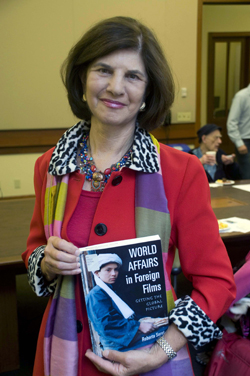Building Bridges of Celluloid
Like many New Yorkers in the weeks after September 11, 2001, Roberta Seret saw a need for greater cultural understanding.
For Seret, Professor of Professional English at the United Nations, where she teaches both English and business to diplomats, it made sense to start with young people – and film seemed an especially powerful medium. In 2003, Seret founded International Cinema Education, a non-profit within the UN that uses foreign films to teach high school students about global issues.
“George Lucas once said that ‘media and technology are important, but without a story, they’re empty,’”Seret told a Gottesman Libraries audience in September during a discussion of her new book, World Affairs in Foreign Films (McFarland Publishers, 2011). “Showing foreign films to U.S. high school students opens up their minds, transporting them, like a flying magic carpet, into all kinds of subjects.”
Seret described how she has helped turn foreign films into a sought-after elective at 15 New York City public schools. For example, she used the acclaimed 2003 Afghan film, Osama, to prompt a discussion that touched on politics, government, history and even economics. Directed by Siddiq Barmak, the film is among 13 feature films explored in World Affairs in Foreign Film, which is designed to serve as a comprehensive resource for teachers of multi-disciplinary academic subjects. Part textbook and part primer, the book includes discussion-starters and homework topics as well as background on nearly 70 other thought-provoking films, including Hotel Rwanda; Beijing Bicycle; Sophie Scholl: The Final Days, from Germany; and Central Station, from Brazil.
Seret, who led a high-school film session last year at TC, said that some students have become so energized after seeing films cited in her book that they have gone on to work for NGOs and fund-raise for worthy causes. “That’s the beauty of film,” she said. “There’s nothing else like it in giving us new voices in such a visual and visceral way.”
Published Wednesday, Oct. 12, 2011
